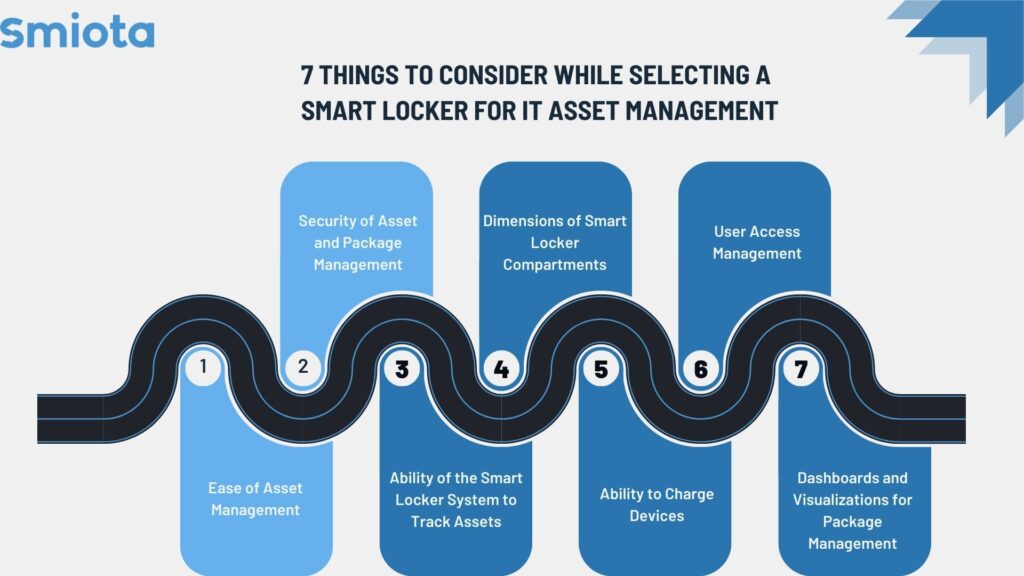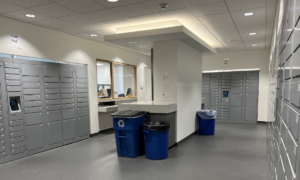Managing IT assets effectively is crucial for organizational efficiency and security, especially as businesses expand and technologies evolve. IT Asset Management (ITAM) solutions are essential for managing IT resources throughout their lifecycle by integrating financial, contractual, and inventory aspects. With the advent of smart lockers, companies now have a sophisticated tool at their disposal to streamline this process. Smart lockers offer a modern solution by streamlining ITAM and improving security and accountability.
This article provides insights for organizations to make informed decisions about smart locker systems, emphasizing the importance of combining physical security with digital intelligence for efficient and secure ITAM.
But first, it’s essential to understand the challenges businesses face in IT asset management. These challenges underscore the necessity for an effective solution and set the stage for why smart lockers are imperative in today’s tech-driven world.
Challenges with IT Asset Management
Asset management, particularly in IT, poses many challenges that can impede operational efficiency and asset optimization. These challenges include maintaining accurate inventory records, ensuring timely maintenance and upgrades, and safeguarding against loss or theft. The complexity increases with the scale of the organization, for instance:
Manual Processes and Errors:
- Traditional methods often rely on manual tracking, leading to time-consuming processes.
- Human errors in data entry and tracking can result in mismanagement of assets.
- Even with a ticket management software, the exchange and handover of IT assets is a tedious task.
Rapid Technological Advancements:
- Keeping up with tech evolution makes asset tracking challenging.
- New devices and software updates require frequent revisions in the asset management system.
Increasing Device Numbers:
- The growing number of IT devices in organizations complicates inventory management. This adds to the queue in the ITSM tool as well as the IT desk.
- Each device may have different management needs and lifecycle stages.
Diversity in Software and Hardware:
- Varied types of software and hardware need different management strategies.
- Compatibility issues between various assets can be challenging to resolve.
Security Concerns:
- High-value or sensitive IT assets are at risk of theft or misuse.
- Ensuring data security in these assets is crucial but challenging.
The emergence of innovative solutions like smart locker systems for ITAM and their benefits marks a transformative shift in overcoming these hurdles.
The transition from grappling with the challenges of asset management to embracing the benefits of smart lockers is a leap towards efficiency, security, and strategic asset optimization. This approach simplifies the management of IT assets. It aligns with the evolving needs of dynamic business environments, paving the way for a more organized, accountable, and efficient asset management system. It offers the following advantages:
- IoT Connectivity for Real-Time Oversight: Smart lockers integrated with the Internet of Things (IoT) provide real-time monitoring and alert systems. This connectivity ensures that any unauthorized access or security breaches are immediately detected and reported, enhancing the overall security of IT assets.
- Centralized Secure Storage: Smart lockers are typically equipped with advanced locking mechanisms and can be accessed only by authorized personnel, ensuring that sensitive items like laptops, tablets, and smartphones are securely stored when not in use.
- Chain of Custody Tracking: Smart lockers enable detailed tracking of who accessed which asset and when. This chain of custody tracking is crucial for maintaining the security of high-value or sensitive IT assets for a clear audit trail in case of any incidents.
- Improved Efficiency: Integrated with IT ticketing systems like ServiceNow, these lockers streamline asset distribution and return, offering quick access to equipment and boosting workflow productivity.
- Cost Savings: Smart lockers reduce costs by keeping precise logs of asset usage, preventing mismanagement, and lowering administrative overhead through automated check-in/check-out processes.
- Enhanced User Experience: Offering self-service access to IT assets, these lockers simplify processes and reduce downtime by facilitating quick responses to IT issues.
- Data Analytics and Reporting: They provide insights into usage patterns and allow customized reporting, aiding inventory optimization and proactive asset management.
Smart lockers bring a transformative approach to IT asset management, making them an invaluable tool in modern organizations. Now, we come to selecting the right smart locker to empower organizational ITAM.
7 Things to Consider While Selecting a Smart Locker for IT Asset Management
When selecting a smart locker for IT asset management, several critical factors must be considered to ensure efficient, secure, and user-friendly operation. Here’s a closer look at the seven key considerations:
Ease of Asset Management
The primary purpose of a smart locker is to streamline the process of managing IT assets. Look for a system that simplifies the check-in and check-out processes, making it quick and easy for users to access the necessary equipment. The system should be intuitive, reducing the need for extensive training or technical support. Also, consider how well the locker integrates with existing IT asset management systems to ensure a seamless workflow.
Security of Asset and Package Management
The security features of a smart locker are paramount. It should offer robust protection against unauthorized access, with features like secure login procedures, tamper alerts, and sturdy physical construction. Additionally, consider how well the system safeguards sensitive data, adhering to compliance standards relevant to your industry. The locker should also track access logs, providing a clear audit trail of who accessed which asset and when. For instance, Smiota’s smart locker solutions for asset management come with SOC2 and ISO2700 compliance.
Ability of the Smart Locker System to Track Assets
Effective tracking is crucial for asset management. The locker should have capabilities to monitor the status of each item, whether it’s in the locker, checked out, or due for return. RFID tags, barcodes, or other tracking technologies can be used for real-time asset tracking, helping to prevent loss and manage inventory efficiently.
Dimensions of Smart Locker Compartments
The size and number of compartments in a smart locker are essential factors based on the types of devices you need to store. Ensure that the lockers can accommodate the sizes of laptops, tablets, and other IT equipment used in your organization. Adjustable shelving or customizable compartment sizes can be a significant advantage, offering flexibility as your asset inventory changes over time.
Ability to Charge Devices
Charging capabilities within the locker compartments can be a game-changer. This feature allows devices to be charged while securely stored, ensuring they are ready for use when needed. Check for the availability of various charging options, including USB ports and traditional power outlets, to cater to different device requirements.
User Access Management
Managing who has access to which assets is crucial for both security and efficiency. The smart locker system should allow for the easy assignment and modification of access rights, possibly integrating with your organization’s existing user management and ticketing systems. The ability to set different access levels based on job role or department can further enhance the system’s effectiveness. For example, Smiota offers its customers an easy-to-use admin portal to manage users without any hassle.
Dashboards and Visualizations for Package Management
A good smart locker system should offer a comprehensive dashboard for administrators, providing insights into usage patterns, asset statuses, and inventory levels. Visualization tools can help quickly identify trends, potential issues (like frequently lost items), and areas for optimization. These dashboards should be user-friendly and provide actionable data to aid in decision-making. Smiota’s smart lockers provide a detailed dashboard that allows IT managers to easily track their assets.
Explore Asset Management Solutions
Final Thoughts on IT Asset Management Using Smart Lockers
By considering these seven key factors, organizations can choose a solution that meets their current needs and adapts to future challenges and technological advancements. Smart lockers represent physical security and digital intelligence, marking a significant step forward in IT asset management.
Additionally, integrating smart lockers with a ticket management system marks a pivotal advancement in operational efficiency. This symbiosis ensures a seamless, automated process for tracking and managing IT assets, i.e., robust ticketing capabilities help monitor, allocate, and retrieve assets, and smart lockers provide secure, controlled, and traceable storage and distribution points, enhancing accountability and asset visibility and elevating the overall user experience, making smart lockers vital for optimizing ITAM.





